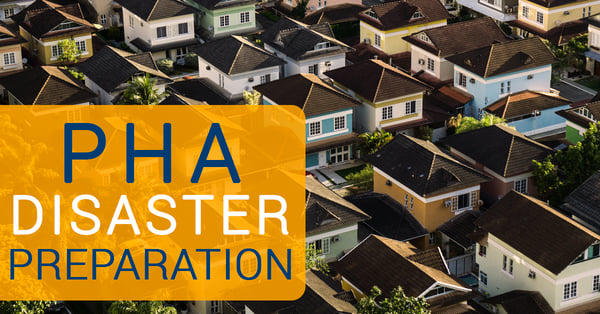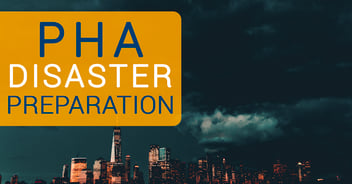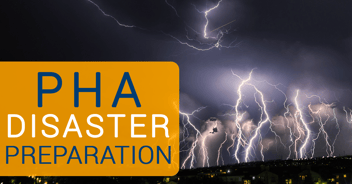How to prepare your PHA for potential disasters - Part 2

Disasters often strike unexpectedly and include a wide range of events. That’s why it’s important to be prepared before a disaster hits your community. By planning for disasters before they happen, you can help ensure your PHA has adequate resources and is ready to respond should a disaster affect your area. The information presented below aims to help your PHA create proper disaster plans and procedures as well as utilize all funding and resources that may be available during and after a disaster. This is a four part series, so be on the lookout for part three coming out next week!
Continuity plans: how planning for the future impacts the present
After completing a thorough risk assessment, the information gathered should be used to create a continuity plan. Doing so will help prepare both PHA staff and residents for various disaster events.
Resiliency strategies
When starting your continuity plans, it’s important to create comprehensive resiliency strategies. As you structure your resiliency strategies, the question should not be if a business disruption will occur, but how the business will endure, respond, and recover from potential disruptions.
The key to creating resiliency strategies is to incorporate them into daily operations (i.e. communication networks, approval procedures, and records management) to ensure that every part of the business will run smoothly in case a disaster impacts one or all of your daily operations.
A good resiliency strategy should include, but not be limited to, the following:
- PHA business operations. Here you should look at how you’ll access staff, documents (whether they are stored in a physical location, in on-site servers, or in cloud-based storage), and communication networks. You’ll need to note whose responsibility it is to access each area and how they will do so. Remember that it's important to plan for situations where large portions of PHA staff may be directly affected by the disaster and unable to provide immediate assistance.
- Impacts on the residents. Research whether staff/property managers are prepared and trained to help residents access food, water, and medication. Staff and property managers should also be trained on how to aid elderly and disabled residents. Trainings and preparation should include specific and unique needs based on each property’s attributes.
- Impact on the physical infrastructure and housing portfolio. You should be looking at the potential damage to buildings, infrastructure, and assets and how you’ll address and repair those damages, should they arise. Special consideration should be given to buildings and areas that are older, frail, have a history of repairs, or are in need of repairs.
The added benefit of implementing resiliency strategies into current operations is that it can often times help identify and improve on program weaknesses and inefficiencies. By planning for the future, you can have a positive impact on today.
Resident safety and business continuity
Resident safety is the top priority for PHAs. In order to ensure your PHA will be able to provide the services needed by residents, a plan needs to make sure there is business continuity during and after a disaster occurs. There are both immediate and ongoing needs for PHAs.
Key components of planning for immediate needs are:
- Facilitating the evacuation of residents prior to an emergency (when a warning is given).
- Providing immediate assistance and resident checks (when no warning is given).
- Creating emergency communication plans and options (e.g. a phone tree).
- Establishing short term shelter options.
- Establishing short term business operation locations.
- Creating an emergency assessment and repairs.
Key components of planning for ongoing needs are:
- Establishing long term temporary housing options.
- Creating a comprehensive assessment, plan, and execution.
- Creating a list of contractors and vendors to help facilitate and complete recovery efforts. This includes locating and maintaining a list of capable contractors for various needs, such as having contractors who specialize in disaster recovery construction work or mold remediation and mitigation companies.
- Establishing a long-term business operation location. You should identify the current capacity needs of a partial and a full office for your PHA.
Planning for immediate and ongoing needs will help you create both short- and long-term plans for you and your staff to carry out. It will also aid greatly in the ability to quickly and properly apply for and acquire available funding, as well as with the rebuilding process after the disaster has happened.
Staff training
Without properly training your staff on how to prepare for and respond to disasters, all of the efforts to prepare may be lost during the actual disaster and the days or weeks after. Your staff should be trained on the emergency business and response plan, how to identify residents that may have special or additional needs (as well as, elderly or persons with disabilities, families with children, and those who may have limited English proficiency), the staff and resident phone tree and contact plan (recommended to be created as part of the continuity plan), and any potential drills.
Resident training
In addition to training your staff, residents may also benefit from trainings on how to respond in case of a disaster. When training residents, you should consider hosting disaster preparation sessions, identifying residents or resident groups who may wish to take on notification or other responsibilities, maintaining emergency contact information in a central location, and posting locations of first aid and emergency supplies. Taking the time to train your residents can not only help your residents feel prepared but can also help your staff during a disaster to know that your residents are taken care of.
Next: Coordination and partnerships, working with local resources and funding sources
About the author

With nearly a decade of experience in the affordable housing industry, James Karner has served with Nan McKay & Associates since 2012 in various roles including quality control, finance, procurement, compliance, and as a trainer. He is currently based in NMA’s Houston office, where he actively works on several CDBG-DR projects including Harris County, Texas and Joplin, Missouri.




